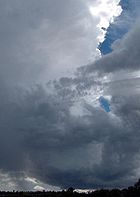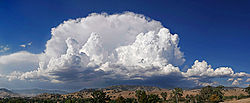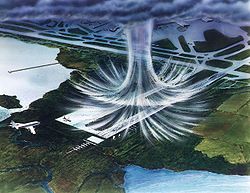
Air-mass thunderstorm
Encyclopedia

Thunderstorm
A thunderstorm, also known as an electrical storm, a lightning storm, thundershower or simply a storm is a form of weather characterized by the presence of lightning and its acoustic effect on the Earth's atmosphere known as thunder. The meteorologically assigned cloud type associated with the...
, is a thunderstorm that is generally weak and usually not severe. These storms form in environments with low Convective Available Potential Energy
Convective available potential energy
In meteorology, convective available potential energy , sometimes, simply, available potential energy , is the amount of energy a parcel of air would have if lifted a certain distance vertically through the atmosphere...
(CAPE) values, low wind shear
Wind shear
Wind shear, sometimes referred to as windshear or wind gradient, is a difference in wind speed and direction over a relatively short distance in the atmosphere...
, and low helicity
Helicity
The term helicity has several meanings. In physics, all referring to a phenomenon that resembles a helix. See:*helicity , the extent to which corkscrew-like motion occurs...
values. The lifting source, which is a crucial factor in thunderstorm development, is usually the result of uneven heating of the surface, though they can be induced by weather front
Weather front
A weather front is a boundary separating two masses of air of different densities, and is the principal cause of meteorological phenomena. In surface weather analyses, fronts are depicted using various colored lines and symbols, depending on the type of front...
s and other low-level boundaries associated with wind convergence
Convergence zone
Convergence zone usually refers to a region in the atmosphere where two prevailing flows meet and interact, usually resulting in distinctive weather conditions....
. The energy needed for these storms to form comes in the form of insolation
Insolation
Insolation is a measure of solar radiation energy received on a given surface area in a given time. It is commonly expressed as average irradiance in watts per square meter or kilowatt-hours per square meter per day...
, or solar radiation. Air-mass thunderstorms do not move quickly, last no longer than an hour, and have the threats of lightning
Lightning
Lightning is an atmospheric electrostatic discharge accompanied by thunder, which typically occurs during thunderstorms, and sometimes during volcanic eruptions or dust storms...
, as well as showery light, moderate, or heavy rainfall. Heavy rainfall can interfere with microwave
Microwave
Microwaves, a subset of radio waves, have wavelengths ranging from as long as one meter to as short as one millimeter, or equivalently, with frequencies between 300 MHz and 300 GHz. This broad definition includes both UHF and EHF , and various sources use different boundaries...
transmissions within the atmosphere.
Lightning characteristics are related to characteristics of the parent thunderstorm, and could induce wildfire
Wildfire
A wildfire is any uncontrolled fire in combustible vegetation that occurs in the countryside or a wilderness area. Other names such as brush fire, bushfire, forest fire, desert fire, grass fire, hill fire, squirrel fire, vegetation fire, veldfire, and wilkjjofire may be used to describe the same...
s near thunderstorms with minimal rainfall. On unusual occasions there could be a weak downburst
Downburst
A downburst is created by an area of significantly rain-cooled air that, after reaching ground level, spreads out in all directions producing strong winds. Unlike winds in a tornado, winds in a downburst are directed outwards from the point where it hits land or water...
and small hail
Hail
Hail is a form of solid precipitation. It consists of balls or irregular lumps of ice, each of which is referred to as a hail stone. Hail stones on Earth consist mostly of water ice and measure between and in diameter, with the larger stones coming from severe thunderstorms...
. They are common in temperate zones during a summer afternoon. Like all thunderstorms, the mean-layered wind field the storms form within determine motion. When the deep-layered wind flow is light, outflow boundary
Outflow boundary
An outflow boundary, also known as a gust front, is a storm-scale or mesoscale boundary separating thunderstorm-cooled air from the surrounding air; similar in effect to a cold front, with passage marked by a wind shift and usually a drop in temperature and a related pressure jump...
progression will determine storm movement. Since thunderstorms can be a hazard to aviation, pilots are advised to fly above any haze layers within regions of better visibility and to avoid flying under the anvil of these thunderstorms, which can be regions where hail falls from the parent thunderstorm. Vertical wind shear
Wind shear
Wind shear, sometimes referred to as windshear or wind gradient, is a difference in wind speed and direction over a relatively short distance in the atmosphere...
is also a hazard near the base of thunderstorms which have generated outflow boundaries
Outflow boundary
An outflow boundary, also known as a gust front, is a storm-scale or mesoscale boundary separating thunderstorm-cooled air from the surrounding air; similar in effect to a cold front, with passage marked by a wind shift and usually a drop in temperature and a related pressure jump...
.
Life cycle
The trigger for the lift of the initial cumulus cloud can be insolationInsolation
Insolation is a measure of solar radiation energy received on a given surface area in a given time. It is commonly expressed as average irradiance in watts per square meter or kilowatt-hours per square meter per day...
heating the ground producing thermals, areas where two winds converge forcing air upwards, or where winds blow over terrain of increasing elevation. The moisture rapidly cools into liquid drops of water due to the cooler temperatures at high altitude, which appears as cumulus
Cumulus cloud
Cumulus clouds are a type of cloud with noticeable vertical development and clearly defined edges. Cumulus means "heap" or "pile" in Latin. They are often described as "puffy" or "cotton-like" in appearance. Cumulus clouds may appear alone, in lines, or in clusters...
clouds. As the water vapor condenses into liquid, latent heat
Latent heat
Latent heat is the heat released or absorbed by a chemical substance or a thermodynamic system during a process that occurs without a change in temperature. A typical example is a change of state of matter, meaning a phase transition such as the melting of ice or the boiling of water. The term was...
is released which warms the air, causing it to become less dense than the surrounding dry air. The air tends to rise in an updraft through the process of convection
Convection
Convection is the movement of molecules within fluids and rheids. It cannot take place in solids, since neither bulk current flows nor significant diffusion can take place in solids....
(hence the term convective precipitation
Precipitation (meteorology)
In meteorology, precipitation In meteorology, precipitation In meteorology, precipitation (also known as one of the classes of hydrometeors, which are atmospheric water phenomena is any product of the condensation of atmospheric water vapor that falls under gravity. The main forms of precipitation...
). This creates a low-pressure zone
Low pressure area
A low-pressure area, or "low", is a region where the atmospheric pressure at sea level is below that of surrounding locations. Low-pressure systems form under areas of wind divergence which occur in upper levels of the troposphere. The formation process of a low-pressure area is known as...
beneath the forming thunderstorm, otherwise known as a cumulonimbus cloud
Cumulonimbus cloud
Cumulonimbus is a towering vertical cloud that is very tall, dense, and involved in thunderstorms and other inclement weather. Cumulonimbus originates from Latin: Cumulus "Heap" and nimbus "rain". It is a result of atmospheric instability. These clouds can form alone, in clusters, or along a cold...
. In a typical thunderstorm, approximately 5×108 kg of water vapor are lifted into the Earth's atmosphere
Earth's atmosphere
The atmosphere of Earth is a layer of gases surrounding the planet Earth that is retained by Earth's gravity. The atmosphere protects life on Earth by absorbing ultraviolet solar radiation, warming the surface through heat retention , and reducing temperature extremes between day and night...
. As they form in areas of minimal vertical wind shear
Wind shear
Wind shear, sometimes referred to as windshear or wind gradient, is a difference in wind speed and direction over a relatively short distance in the atmosphere...
, the thunderstorm's rainfall creates a moist and relatively cool outflow boundary with undercuts the storm's low level inflow, and quickly causes dissipation. Waterspout
Waterspout
A waterspout is an intense columnar vortex that occurs over a body of water and is connected to a cumuliform cloud. In the common form, it is a non-supercell tornado over water. While it is often weaker than most of its land counterparts, stronger versions spawned by mesocyclones do occur...
s, small hail, and strong wind gusts can occur in association with these thunderstorms.
Where they form
Also known as single cell thunderstorms, these are the typical summer thunderstorms in many temperate locales. They also occur in the cool unstable air which often follows the passage of a cold front from the sea during winter. Within a cluster of thunderstorms, the term "cell" refers to each separate principal updraft. Thunderstorm cells occasionally form in isolation, as the occurrence of one thunderstorm can develop an outflow boundary which sets up new thunderstorm development. Such storms are rarely severe and are a result of local atmospheric instability; hence the term "air mass thunderstorm". When such storms have a brief period of severe weather associated with them, it is known as a pulse severe storm. Pulse severe storms are poorly organized due to the minimal vertical wind shear in the storm's environment and occur randomly in time and space, making them difficult to forecast. Between formation and dissipation, single cell thunderstorms normally last 20–30 minutes.Motion

Troposphere
The troposphere is the lowest portion of Earth's atmosphere. It contains approximately 80% of the atmosphere's mass and 99% of its water vapor and aerosols....
, or the lowest 8 kilometres (5 mi) of the Earth's atmosphere
Earth's atmosphere
The atmosphere of Earth is a layer of gases surrounding the planet Earth that is retained by Earth's gravity. The atmosphere protects life on Earth by absorbing ultraviolet solar radiation, warming the surface through heat retention , and reducing temperature extremes between day and night...
. Younger thunderstorms are steered by winds closer to the Earth's surface than more mature thunderstorms as they tend not to be as tall. If the gust front, or leading edge of the outflow boundary, moves ahead of the thunderstorm, the thunderstorm's motion will move in tandem with the gust front. This is more of a factor with thunderstorms with heavy precipitation (HP), such as air-mass thunderstorms. When thunderstorms merge, which is most likely when numerous thunderstorms exist in proximity to each other, the motion of the stronger thunderstorm normally dictates future motion of the merged cell. The stronger the mean wind, the less likely other processes will be involved in storm motion. On weather radar
Weather radar
Weather radar, also called weather surveillance radar and Doppler weather radar, is a type of radar used to locate precipitation, calculate its motion, estimate its type . Modern weather radars are mostly pulse-Doppler radars, capable of detecting the motion of rain droplets in addition to the...
, storms are tracked by using a prominent feature and tracking it from scan to scan.
Convective precipitation

Convective rain, or showery precipitation, occurs from cumulonimbus clouds. It falls as showers with rapidly changing intensity. Convective precipitation falls over a certain area for a relatively short time, as convective clouds such as thunderstorms have limited horizontal extent. Most precipitation in the tropics
Tropics
The tropics is a region of the Earth surrounding the Equator. It is limited in latitude by the Tropic of Cancer in the northern hemisphere at approximately N and the Tropic of Capricorn in the southern hemisphere at S; these latitudes correspond to the axial tilt of the Earth...
appears to be convective. Graupel and hail
Hail
Hail is a form of solid precipitation. It consists of balls or irregular lumps of ice, each of which is referred to as a hail stone. Hail stones on Earth consist mostly of water ice and measure between and in diameter, with the larger stones coming from severe thunderstorms...
are good indicators of convective precipitation and thunderstorms. In mid-latitudes, convective precipitation is intermittent and often associated with baroclinic boundaries such as cold front
Cold front
A cold front is defined as the leading edge of a cooler mass of air, replacing a warmer mass of air.-Development of cold front:The cooler and denser air wedges under the less-dense warmer air, lifting it...
s, squall line
Squall line
A squall line is a line of severe thunderstorms that can form along or ahead of a cold front. In the early 20th century, the term was used as a synonym for cold front. It contains heavy precipitation, hail, frequent lightning, strong straight-line winds, and possibly tornadoes and waterspouts....
s, and warm front
Warm front
A warm front is a density discontinuity located at the leading edge of a homogeneous warm air mass, and is typically located on the equator-facing edge of an isotherm gradient...
s. High rainfall rates are associated with thunderstorms with larger raindrops. Heavy rainfall leads to fading of microwave transmissions starting above the frequency of 10 gigahertz (GHz), but is more severe above frequencies of 15 GHz.
Lightning

Relationships between lightning frequency and the height of precipitation within thunderstorms have been found. Thunderstorms which show radar returns above 14 kilometres (8.7 mi) in height are associated with storms which have more than ten lightning flashes per minute. There is also a correlation between the total lightning rate and the size of the thunderstorm, its updraft velocity, and amount of graupel over land. The same relationships fail over tropical oceans, however. Lightning from low precipitation (LP) thunderstorms is one of the leading causes of wildfire
Wildfire
A wildfire is any uncontrolled fire in combustible vegetation that occurs in the countryside or a wilderness area. Other names such as brush fire, bushfire, forest fire, desert fire, grass fire, hill fire, squirrel fire, vegetation fire, veldfire, and wilkjjofire may be used to describe the same...
s.
Aviation concerns
In areas where these thunderstorms form in isolation and horizontal visibility is good, pilots can evade these storms rather easily. In more moist atmospheres which become hazy, pilots navigate above the haze layer in order to get a better vantage point of these storms. Flying under the anvil of thunderstorms is not advised, as hailHail
Hail is a form of solid precipitation. It consists of balls or irregular lumps of ice, each of which is referred to as a hail stone. Hail stones on Earth consist mostly of water ice and measure between and in diameter, with the larger stones coming from severe thunderstorms...
is more likely to fall in such areas outside the thunderstorm's main rain shaft. When an outflow boundary forms due to a shallow layer of rain-cooled air spreading out near ground level from the parent thunderstorm, both speed and directional wind shear can result at the leading edge of the three dimensional boundary. The stronger the outflow boundary is, the stronger the resultant vertical wind shear will become.

